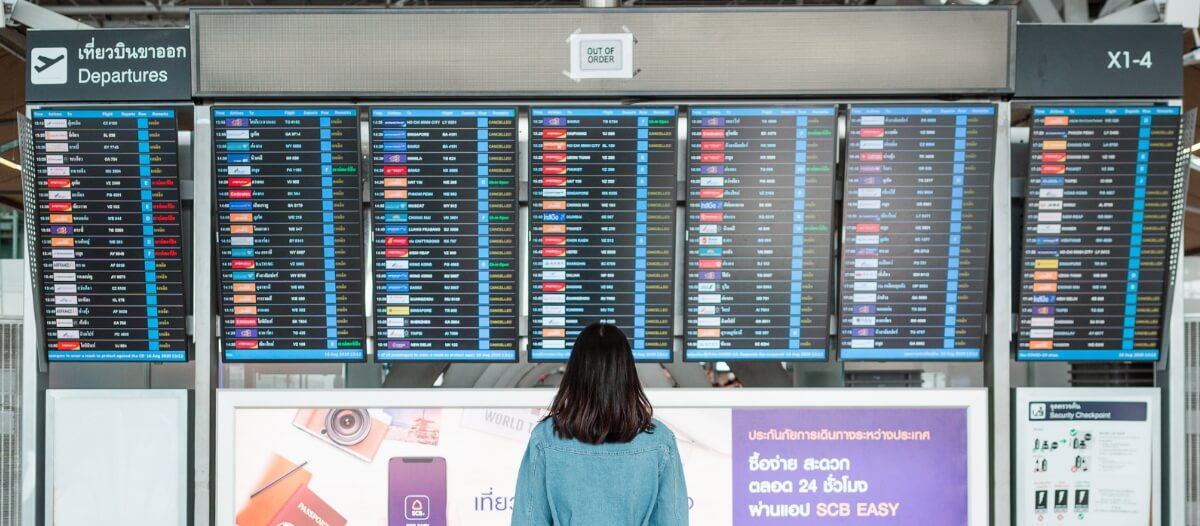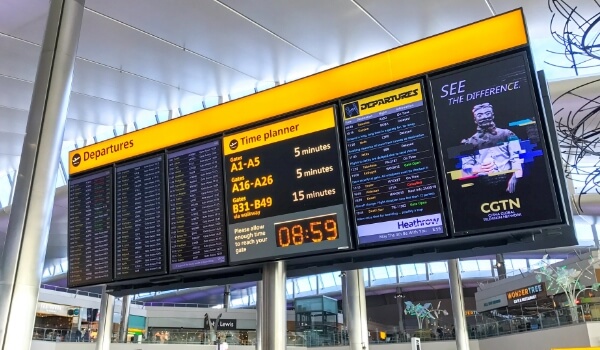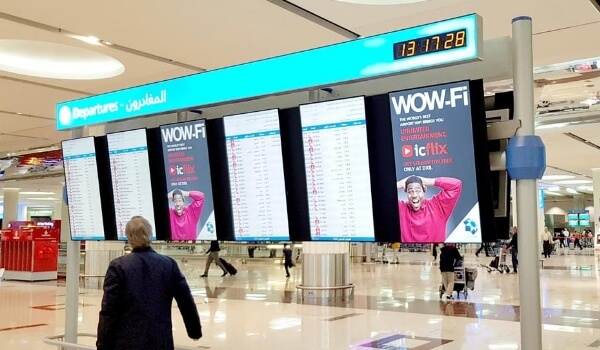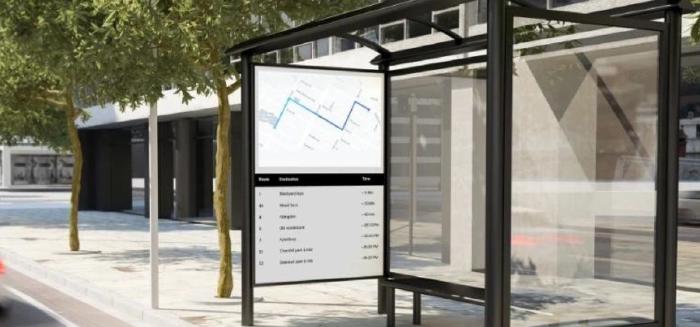
Oct 18 2022
10 min read


May
Have you seen those screens at the airport that show flight details in real-time? Those displays are called FIDS or flight information display system.
These screens are essential to update passengers about their flight timings, flight schedules and more. But more than that, these screens are also used for handling crowds at the airports, running ads, showing emergency messages, and displaying important announcements for the passengers.
Let us understand how the FIDS system works, which airports are using the system to their advantage, and how can the system be used alongside advertised content.
A Flight Information Display System, commonly known as FIDS, is a crucial airport component. Its primary objective is to showcase real-time flight status, estimated arrival times, display gate numbers, and more.
Since its inception, FIDS has undergone many transformations striving to provide an upgraded, aesthetically rich passenger experience. But beyond that, the changes have led to airports sharing accurate information at the fastest possible time with maximum automation.
Modern Flight Information Display Systems have digital Passenger Information Display software integrations, making it convenient for the staff to manage the displayed content remotely.
Here are some of the different types of information that can be shown using a FIDS:
1. Flight details: Real-time flight updates like flight origin, arrival and departure time on screen, airline code, flight status as in landing, delayed or early, gate number, and things like that
2. Airport information: Updates on weather forecast, baggage drop information, security check guidelines, wayfinding map, etc.
3. Infotainment: Interesting feeds and infotainment, including local news, sports news, popular travel hacks, entertainment videos, and social media feeds.
Book My personalized demoA user-friendly flight display system uses an interface that assembles and delivers media information on dynamic LED screens at any international airport. It is valuable across multiple transportation hubs such as airports, bus terminals, railway stations, etc. FIDS operation can be understood in three main phases:
The Flight Information Display System FIDS software gathers data from internal and external sources. The major ones are the Airport Operational Database (AODB), Resource Management System, Public Transportation Data Feeds, and Alert & Warning Systems. The software assimilates with these management systems via data integration & API to pull the required data.
Next, system operators custom design the FIDS screen layouts or use handy templates to arrange, design, and publish the data on the airport display monitors. The digital signage software vendor may also offer various customizations to meet the airport’s unique business needs.
The FIDS software further allows automation and scheduling of content on the airport announcement boards. The airport system operators can use a centralized Content Management System (CMS) to update, line up, create a playlist, or create flash alerts for different types of on-screen content.
Several airports worldwide have adopted innovative FIDS architectures. Let us explore a few:
The management division of Singapore’s Changi Airport recruited an experienced team to bring a passenger-centric approach to its flight information displays. They wanted to set the bar higher by informing, engaging, and entertaining the passengers innovatively.
The Singapore airport placed large LED displays to offer detailed flight information and digital signage kiosk booths where passengers can get only the information they want.
These flight information kiosks allow passengers to scan their boarding passes and get flight information like which terminal to head to and how to reach there. It even shows an animated direction using a 3D wayfinding map.
See how it works in the video below:
In a creative twist, Heathrow Airport celebrated Star Wars Day using FIDS in an innovative, out-of-the-box style in 2018.
The airport arrival & departure boards displayed the schedule of flights to Jakku, Alderaan, Death Star, and places like that. YES! To the galaxies!
Take a look at this airport screen and say if it doesn’t amuse you beyond your imagination:

Moving away from traditional systems, Dubai Airport embraced a new cloud-based Flight Information Display System (FIDS) solution coded with a system-on-chip (SoC) technology to provide passengers with an extraordinary experience.

The new flight information screen system at Dubai Airports allowed easy operation via the internet browser without any local software installation. The staff could choose a variety of screen layouts and select specific contents for different zones in that layout, and display multiple contents simultaneously at the same time.
Thanks to cloud-based software, everything stood manageable from a remote location on any device. The deployment of the new and user-friendly system improved operational efficiency and passenger experience simultaneously.
Here are some reasons why airports should have FIDS in place:
Real-time flight updates ensure efficient crowd movement. This involves continuously providing passengers with the latest information regarding flight schedules, gate changes, delays, cancellations, and boarding times.
Consider an airport like Delhi’s International Airport, which handles a many international flights daily. Recently there was a sudden delay in multiple flights due to unforeseen weather. The FIDS immediately reflects these changes, showing updated departure times and gate information. Passengers are notified through the airport’s PA system and via updates on their mobile apps. This can help avoid crowding at the gates helping passengers disperse to various parts of the airport.
One of the most critical aspects of airport navigation is ensuring that passengers from all over the world can find their way around easily. FIDS can display wayfinding information in multiple languages. This is particularly useful in international airports where travelers speak a variety of languages.
Consider an international airport like Dubai International Airport, which serves passengers from across the globe. The FIDS here could display wayfinding directions not only in English and Arabic but also in other widely spoken languages like Mandarin, Spanish, and Hindi. This personalized approach makes navigation much simpler for non-native speakers and enhances the overall airport experience.
Flight Information Display Systems (FIDS) transcend their traditional role of displaying flight schedules by also serving as a vibrant platform for broadcasting a wide array of local news and events. This multifaceted feature transforms FIDS into an interactive tool that not only informs but also enriches the passenger experience by connecting them with the pulse of the city. For newcomers, this real-time insight into local happenings can be a deciding factor in exploring the city, potentially enhancing their visit.
Meanwhile, for residents returning home, it offers a quick and convenient update on recent happenings in their area. Highlighting the technical aspects of delivering dynamic and diverse content, including social media integration and live updates, would provide a comprehensive view of how FIDS can be optimized for infotainment, making it an essential element in elevating the airport experience.
The use of Flight Information Display Systems (FIDS) in airports significantly reduces the need for a large number of ground staff dedicated to answering passenger queries about flight status, timings, and other related information. This is achieved by effectively communicating necessary information through digital screens, thereby streamlining operations and cutting costs.
By leveraging FIDS for disseminating flight-related information, airports can significantly reduce their reliance on ground staff for answering routine passenger queries. This leads to cost savings and a more streamlined, efficient operation, while simultaneously enhancing the passenger experience through easy access to information.
Airports can use FIDS screens to advertise and promote their services.Airports can strategically use Flight Information Display Systems (FIDS) not only for displaying flight-related information but also as a platform for advertising and promoting various services. This dual functionality of FIDS screens offers a valuable opportunity for both the airport and external brands to reach a wide and diverse audience.
Lastly, airport staff can manage the heavy number of passengers more efficiently by displaying security check guidelines, flight updates, general FAQs, and essential travel information on the airport monitors.This approach is particularly effective in enhancing operational efficiency and improving passenger satisfaction.
A traveler’s journey from arriving at the airport to boarding the flight home should not feel intimidating. With easily accessible information, passengers feel more at ease. As airports continuously seek ways to enhance the travel experience, FIDS stands out as a game-changer.
Take complete control of what you show on your digital signage & how you show it.
Take complete control of what you show on your digital signage & how you show it.
Start Free Trial Schedule My Demo
Oct 18 2022
10 min read

Sep 21 2023
7 min read

Apr 25 2023
4 min read

Dec 22 2022
5 min read